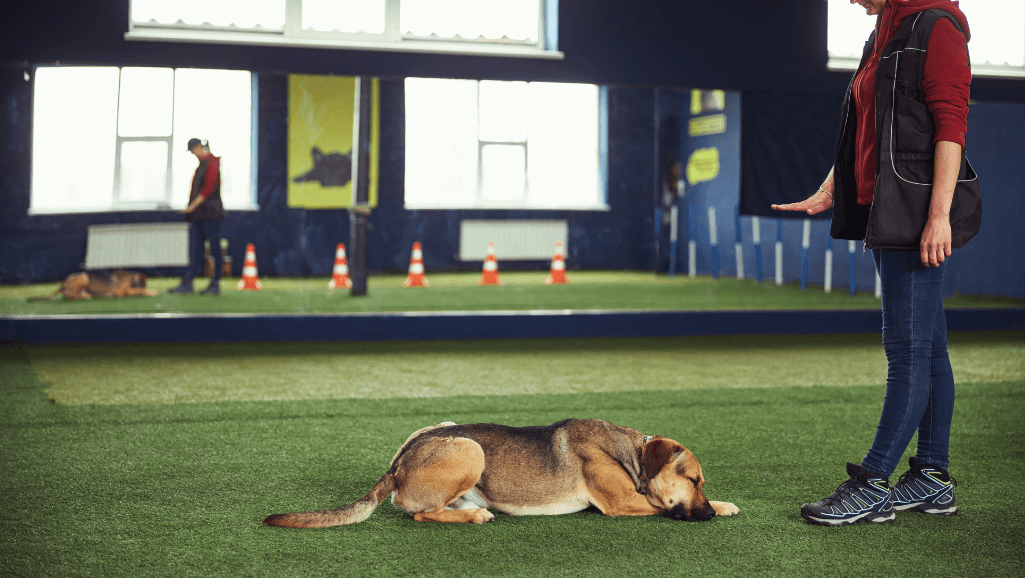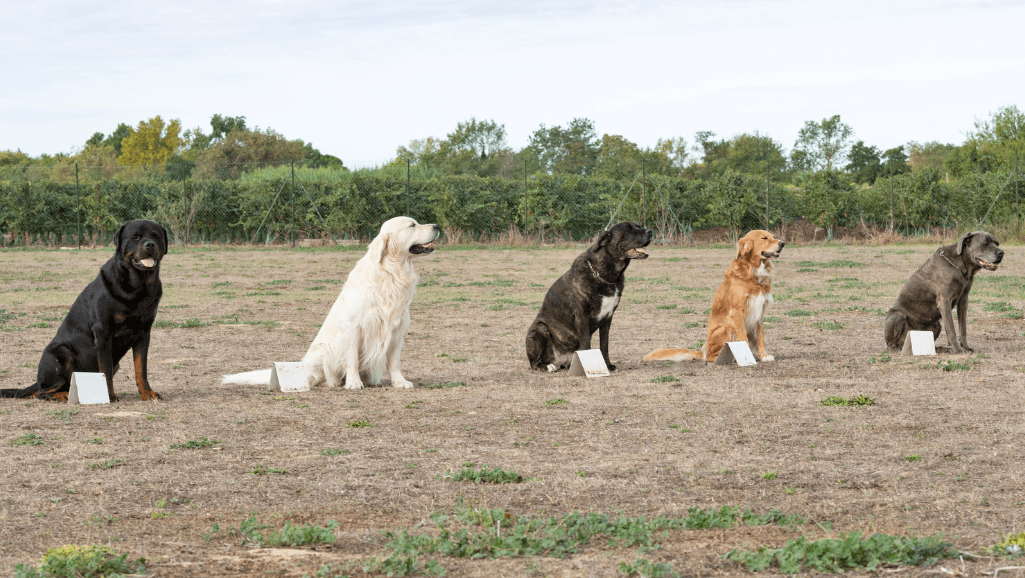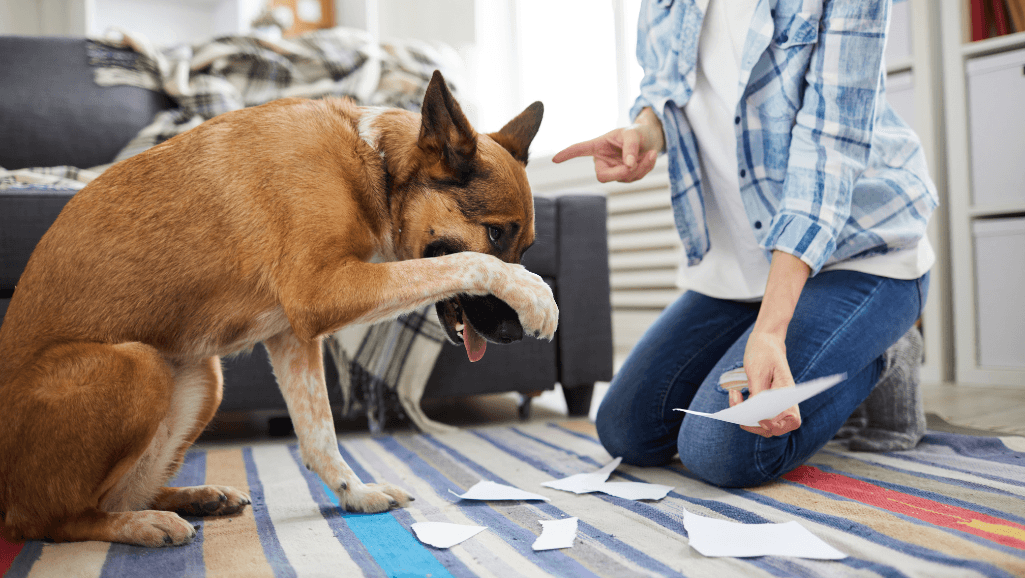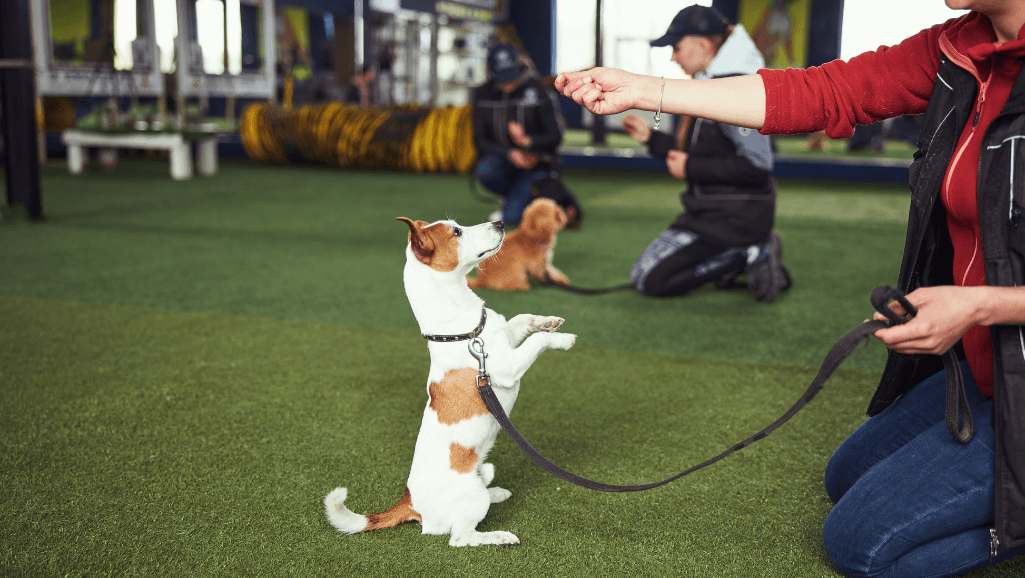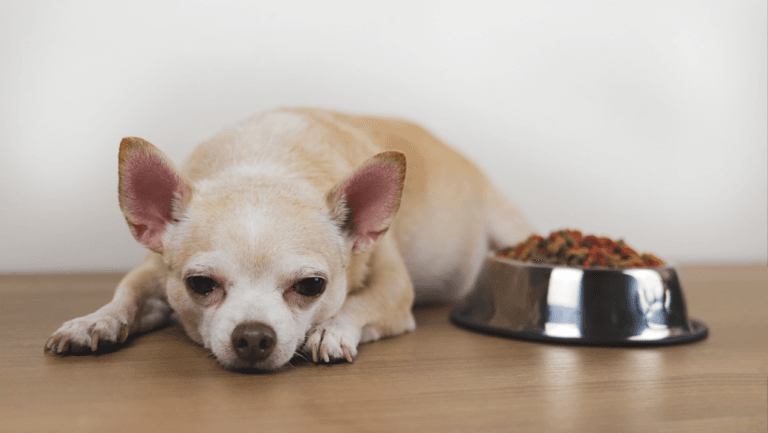Teaching your dog to lay down is key in dog obedience training. The ‘lay down’ command is basic but very useful. It keeps them safe and helps them calm down. You can teach it using luring, shaping, or capturing, all with treats and praise.
With luring, hold a treat near your puppy’s nose and move it in a circle. This encourages them to spin and lay down. Shaping involves teaching in small steps, like looking at the ground and then lowering their elbows. The capture method rewards your puppy for lying down naturally, helping them learn to do it on command.
Think about your dog’s body when picking a training method. Some breeds, like greyhounds, might find sitting hard. You can use a blanket or adjust the setup to help them learn. If your dog already sits, teaching them to lie down will be easier. It’s a good start for more commands like stay or settle.
Key Takeaways
- How to Teach a Dog to Lay Down
- Use positive reinforcement techniques, such as treats and praise, to encourage the desired behavior
- Choose a training method (luring, shaping, or capturing) that suits your dog’s learning style and physical characteristics
- Avoid forcing your puppy into the down position, as it may lead to resistance or fear
- Reward your puppy while they are in the down position to effectively reinforce the behavior
- Gradually phase out treat rewards once your dog has learned the command, while maintaining praise as positive reinforcement
Understanding the ‘Lay Down’ Command
Teaching your dog the “lay down” command is key in dog behavior modification and basic obedience. This command keeps your dog in check and strengthens your bond. It also gives your dog mental stimulation.
Importance of Basic Commands
Basic commands like “lay down” are vital for a well-behaved dog. They help you control your pet in many situations. This includes when guests come over or during walks.
Teaching your dog to lay down can calm them in busy times. It’s also useful when you need them to stay in one spot for a while.
Benefits for Dog and Owner
Learning the “lay down” command has many benefits for both dogs and owners. For dogs, it provides mental stimulation and makes them feel secure. Reward-based dog training, which uses treats and praise, reinforces good behavior.
“Teaching a dog the ‘lay down’ command is considered an important basic command that all dogs should know.”
By teaching your dog to lay down, you can stop unwanted behaviors. This includes jumping on people or running off during walks. It makes life easier for you and ensures your dog is well-behaved.
Preparing for Training
Before starting to teach your dog the “lay down” command, prepare well. Pick a quiet, distraction-free spot for training. This could be a big room in your home or a fenced backyard.
Then, get all the training supplies you need. High-value dog training treats are a must, as 99% of dogs love tasty rewards. Choose small, soft treats that can be easily broken into pieces. If you’re using clicker training, make sure you have your clicker ready.
Choosing the Right Environment
The best training spot should have no distractions like other pets, kids, or loud noises. Dogs learn best when they can focus on you and the task. Set up a comfy space with a soft surface, like a towel or bathmat, to make training fun for your dog.
Gathering Training Supplies
You’ll also need a leash and collar for keeping your dog close during training. Toys can be great rewards or keep your dog interested between training sessions.
Good preparation is essential for a successful training session. By choosing the right place and getting all your supplies ready, you and your dog will do great as you start learning the “lay down” command.
The Best Time to Train Your Dog
Timing is everything when it comes to puppy training basics. The best time to start is around 8 weeks old. At this age, puppies are eager to learn and pick up good habits.
For effective training, keep sessions short and frequent. They should last 5 to 10 minutes. Puppies can’t focus for long, so short, fun sessions are best.
Ideal Age for Training
While 8 weeks is the best start, it’s never too late. Adult dogs can learn too, with patience and consistency. But starting early has big benefits:
- Puppies are more open to new things
- Early training strengthens your bond
- It’s key for socialization during the first 16 weeks
How Often to Train
Consistency is key in puppy training basics. Have many short sessions a day. Here’s how to make training effective:
- Train when your puppy is calm, like after play
- Make training part of your daily routine
- Use treats to keep your puppy interested
- Always end on a positive note, even if it’s a repeat command
“The more often you train your puppy, the faster they will learn and the stronger your bond will become.” – Victoria Stilwell, renowned dog trainer
Every puppy learns at their own pace. Be patient and consistent. Celebrate their successes. With effort and positive training, you’ll have a well-behaved, happy dog.
Effective Training Techniques
Teaching your dog to lay down can be done with several effective methods. Positive reinforcement training is a great way to encourage good behavior. It rewards your dog for actions you want them to do. Most dogs, 99%, are motivated by food or treats during training.
Luring with treats is a popular method. You use a treat to guide your dog into the down position. Hold the treat near their nose and slowly move it down. Say “down” when their elbows touch the ground and give them the treat.
Verbal cues and hand signals are also important. After your dog learns to follow the lure, add a verbal cue like “down.” Use the same cue and hand signal every time to avoid confusion.
Clicker Training for Dogs
Clicker training for dogs is another effective method. The clicker marks the exact moment your dog does the right thing. Click quickly and consistently, then give a treat. As your dog gets better, use fewer treats and more verbal cues.
“Consistency in cues among all household members is essential to avoid confusion for the dog.” – Dog Training Expert
Positive reinforcement is key to successful dog training. Rewarding your dog builds their confidence and strengthens your bond. With patience and the right techniques, your dog will learn the “lay down” command.
Step-by-Step Guide to Teaching ‘Lay Down’
Teaching your dog to lay down is a key skill. It requires patience and consistent training. By following simple steps and using positive reinforcement, you can teach your dog this important behavior.
Step 1: Starting with a Sit
First, make sure your dog knows the “sit” command. Have them sit in front of you using a treat or a verbal cue. Once they’re sitting, you can move on to the next step.
Step 2: Lowering into a Lay Down
With your dog sitting, hold a treat near their nose. Slowly move the treat down towards the ground. This will help your dog follow with their nose, bending their elbows and lowering their body.
When your dog’s elbows touch the ground, say “down” in a friendly tone. This links the command to the action. Practice for 10 minutes, repeating several times a day.
Positive reinforcement is key to training dogs, and using treats is the most productive way to teach a dog to lay down.
Step 3: Rewarding Success
Right after your dog lays down, give them a treat and lots of praise. This positive feedback will make them want to do it again. As they get better, wait a bit longer before giving them a treat.
Every dog learns at their own speed. Be patient and keep training consistently. Some dogs might learn quickly, while others need more time. With positive reinforcement and short training sessions, you’ll teach your dog to lay down in no time.
Common Mistakes to Avoid
Starting dog obedience training can be tricky. Two big mistakes are using too many treats and not being clear with commands.
Overusing Treats
Treats are great for training, but too much can be bad. If a dog only listens for treats, they might not obey without them. To fix this, start using treats less and less. Reward with a treat from the other hand to teach without dependence.
Learning to lie down on command can take a few sessions. But every dog is unique. Be patient and stay positive to help them learn.
Inconsistency in Cues
Using the same cues is key. Dogs get confused if commands change. Stick to one way to say or signal a command to avoid confusion.
Command nagging, where owners repeat commands, can lead to dogs ignoring cues. Repeating commands can teach dogs that they can respond whenever they want.
Stay calm and patient during training. Getting angry can hurt your dog’s learning. Dogs sense their owner’s feelings, so keep training positive.
Avoid these mistakes to help your dog succeed in obedience training. Every dog learns differently. Be patient, consistent, and always think of your dog’s well-being.
Reinforcement and Encouragement
Teaching your dog the “lay down” command is easier with positive reinforcement. Reward your dog with praise and treats when they do it right. This method not only speeds up learning but also strengthens your bond.
Patience is essential in dog training. Never push your dog to lie down, as it can cause fear. If your dog finds it hard, break the training into smaller steps. Make sure everyone uses the same commands and hand signals to avoid confusion.
Positive Reinforcement Techniques
Timing is key in positive reinforcement. Reward your dog immediately after they lie down. This links the reward to the action. Use tasty treats to motivate your dog during training.
“Dogs are quicker to learn hand signals compared to vocal commands.” – One Mind Dogs
Use continuous reinforcement when teaching a new behavior. Reward your dog every time they lie down. Later, switch to rewarding them less often to keep the behavior. Gradually build up to the final goal by rewarding small steps.
Importance of Patience
Every dog learns at their own speed. Some might learn fast, while others need more time. Stay patient and keep training regularly.
Training should be short and focused, ideally 1-2 times a week. Choose a quiet place to train for better results. If you get frustrated, take a break and try again later. A positive and upbeat training environment will keep your dog eager to learn.
Troubleshooting During Training
Teaching your dog the “lay down” command can be challenging. It’s important to be patient and understanding. Every dog learns at their own pace. The goal is to make training a positive experience for both you and your dog.
Dealing with Resistance
Some dogs may not want to lie down, maybe because the surface is hard or cold. Offer a soft, comfortable spot like a mat or carpet. Never push your dog to lie down, as it can make them dislike the command. If your dog keeps resisting, check for health issues like joint pain or arthritis. Talk to your vet to see if there’s a medical reason.
When your dog resists, stay calm and patient. Excessive licking or other stress signs mean your dog might be anxious or stressed. Take a break and think about how you’re training. Break the command into smaller steps and reward your dog for each small success.
Progressing at Your Dog’s Pace
Every dog learns differently, and some need more time to learn the “lay down” command. Don’t compare your dog to others. Celebrate their own successes. Consistency and repetition are key, so keep up regular training sessions.
“Patience is a virtue, specially in dog training. Celebrate your dog’s progress, no matter how small, and remember that every step forward is a success.”
If your dog finds it hard with the usual luring method, try other ways like shaping or capturing. Shaping breaks down the behavior into small steps and rewards each step. Capturing catches your dog in the act of lying down and rewards them. Tailor your training to fit your dog’s learning style to help them learn the command better.
Advanced Techniques for Stubborn Dogs
Training stubborn dogs can be tough, but there are advanced methods to help. These techniques aim to boost motivation and engagement. This makes your dog more likely to follow commands.
Additional Rewards
Using higher-value treats is a good strategy. Standard treats might not excite stubborn dogs enough. Try different treats like cooked chicken, cheese, or liver to see what works best for your dog. Always use small treats to prevent overfeeding.
Clicker training is also great for stubborn dogs. It uses a device that makes a clicking sound to mark good behavior. This sound is followed by a treat, linking the action to the reward. It’s a powerful way to teach positive behaviors.
Engaging in Play
Adding play to training can really motivate stubborn dogs. Many dogs love playtime and it keeps them focused on you. Use tug toys or short play sessions as rewards for good behavior. This makes training fun and strengthens your bond.
“Patience and consistency are key to effectively training stubborn dogs.”
Every dog is different, so what works for one might not work for another. Be patient and try various techniques until you find what works for your dog. With persistence and positive reinforcement, even the toughest dogs can learn to follow commands.
Maintaining the ‘Lay Down’ Command
Congratulations on teaching your dog the ‘lay down’ command! But, the journey doesn’t end here. To keep your dog responding to this dog command, regular practice and reinforcement are key.
Start by practicing in places your dog knows well, like your home or backyard. As they get better, try new places and distractions. Keep training short, about 10 minutes, to keep your dog interested.
Regular Practice Sessions
Consistency is important for reinforcing the ‘lay down’ command. Set aside time each day for practice. Use treats, praise, and clicker training to encourage your dog. As they get better, ask them to do it from farther away.
“Down” is one of the ten required skills for both puppies and adult dogs to complete the AKC Virtual Home Manners (VHM) title.
Incorporating into Daily Routine
Also, add the ‘lay down’ command to your dog’s daily routine. Ask them to lay down before meals, during grooming, or when guests come. This makes the command important in different situations.
Dogs communicate a lot with body language. Lying down means they’re calm and friendly. By mastering this command, your dog will be well-behaved and welcome in other homes.
Socializing Your Dog with Commands
Socializing your dog and teaching basic commands is key. Once your dog knows how to ‘lay down,’ it’s time to practice in public. This makes them calm and well-behaved in different places.
Studies show over 90% of dog owners think basic commands like “sit” and “stay” are vital. Training your dog and exposing them to new situations makes them more confident. This helps them handle interactions and emergencies better.
“Socializing behaviors related to training your dog with commands play a critical role in establishing trust and proper communication.”
Interacting with Other Dogs
When meeting other dogs, teach your dog to lay down first. This helps them stay calm and not get too excited or aggressive. Here are some tips for socializing your dog:
- Introduce them to adult dogs, puppies, and cats to widen their social circle
- Teach them basic commands like “sit,” “stay,” and “come” for control in tough situations
- Give them treats and praise for good behavior to encourage positive interactions
Practicing in Public Spaces
Going to parks, pet stores, or busy streets is great for practicing commands. Crate training can also help in these situations. It gives your dog a safe place if they feel scared or overwhelmed. Here’s what to do:
- Begin with short visits to quiet places and gradually move to busier areas
- Carry lots of treats to reward good behavior and keep your dog focused
- Be patient and consistent, as it may take time for your dog to get used to new places
By socializing your dog and practicing commands in different places, you’ll have a well-trained, confident, and happy companion. They’ll be welcome in public and around guests, making outings and gatherings more fun for everyone.
Conclusion and Next Steps
Teaching your dog to “lay down” is key in puppy training. Follow our step-by-step guide and use positive methods. This will help your dog learn to lay down when asked.
Remember, 74% of dogs love treats as rewards. Training in a quiet, familiar spot can make them more focused by 68%. Using both verbal cues and hand signals can make training 83% successful.
Positive reinforcement can make training 90% successful. This means rewarding your dog for good behavior.
Recap of Key Points
First, pick the right place to train. Use treats to lure your dog and give clear commands and hand signals. Be patient and consistent, rewarding your dog with treats and praise.
Avoid using too many treats or being too inconsistent. If your dog is resistant, go slower and use more rewards or play. Regular practice and daily routines will help your dog learn the “lay down” command.
Further Training Opportunities
Once your dog learns the “lay down” command, you can teach more. This command is a base for advanced training, like service dog work. It helps your dog learn more complex tasks and behaviors.
Consistency in rewards speeds up learning by 75%. Clicker training can improve retention by up to 80%.
The “lay down” command is vital for obedience and your dog’s safety. With dedication and the right methods, you and your dog can grow closer. Enjoy the journey of training and the joy of teaching your dog this important command.

